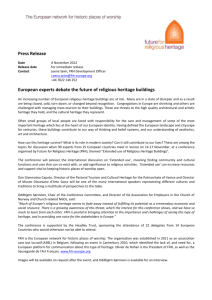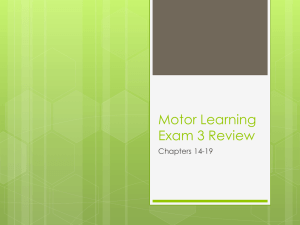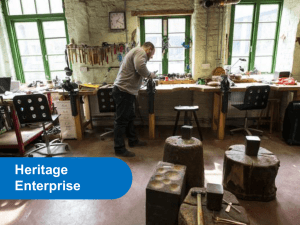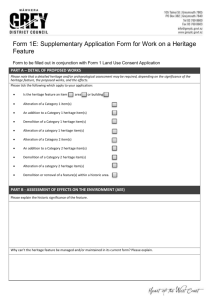Augmented Reality permeating the historical process
advertisement
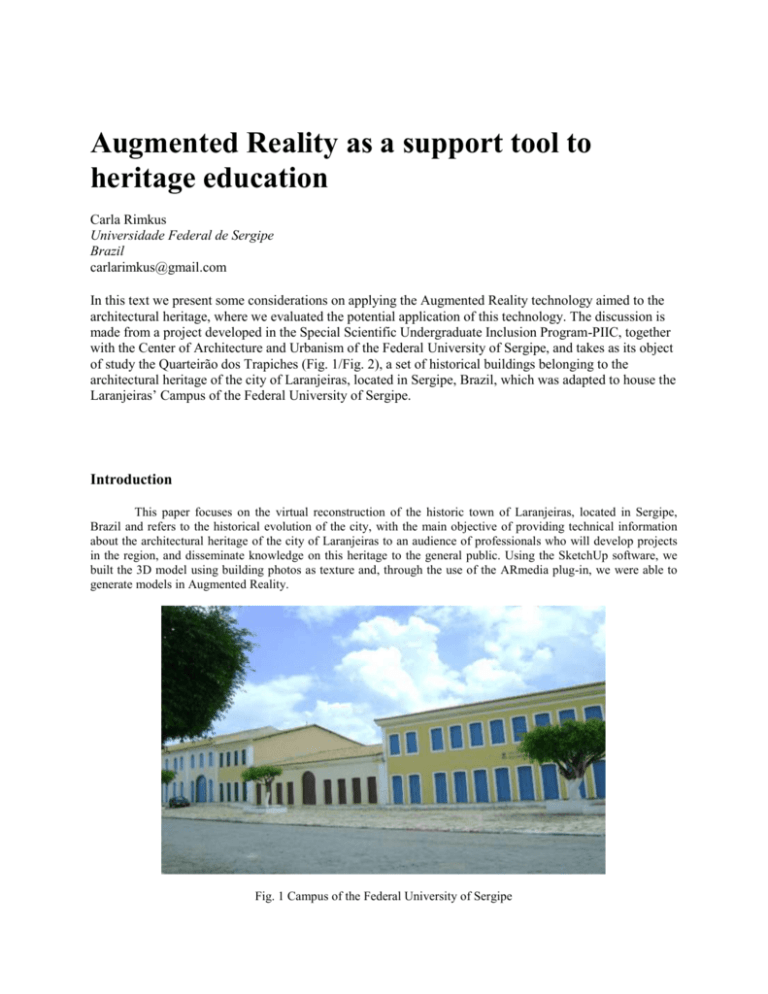
Augmented Reality as a support tool to heritage education Carla Rimkus Universidade Federal de Sergipe Brazil carlarimkus@gmail.com In this text we present some considerations on applying the Augmented Reality technology aimed to the architectural heritage, where we evaluated the potential application of this technology. The discussion is made from a project developed in the Special Scientific Undergraduate Inclusion Program-PIIC, together with the Center of Architecture and Urbanism of the Federal University of Sergipe, and takes as its object of study the Quarteirão dos Trapiches (Fig. 1/Fig. 2), a set of historical buildings belonging to the architectural heritage of the city of Laranjeiras, located in Sergipe, Brazil, which was adapted to house the Laranjeiras’ Campus of the Federal University of Sergipe. Introduction This paper focuses on the virtual reconstruction of the historic town of Laranjeiras, located in Sergipe, Brazil and refers to the historical evolution of the city, with the main objective of providing technical information about the architectural heritage of the city of Laranjeiras to an audience of professionals who will develop projects in the region, and disseminate knowledge on this heritage to the general public. Using the SketchUp software, we built the 3D model using building photos as texture and, through the use of the ARmedia plug-in, we were able to generate models in Augmented Reality. Fig. 1 Campus of the Federal University of Sergipe Fig. 2 Implementation of the Quarteirão dos Trapiches, a set of historic buildings where the Laranjeiras’ campus of the Federal University of Sergipe is currently located The historic city of Laranjeiras The city of Laranjeiras undergoes a process of rehabilitation and conservation of its architectural heritage, implemented by the Monumenta Program. This city was founded in 1605 and is the second oldest city of Sergipe, holding an architectural heritage of inestimable historical value. This urban and architectural ensemble that congregates a historical past of the colonial period, and at certain times of the Brazilian neo-classicism and eclecticism, tells the history of a city that holds traces of the Brazilian cultural wealth, which is classified as one of the most important architectural heritage of the Brazil, heritage listed by IPHAN; nevertheless, despite its importance, we could verify the lack of technical documentation regarding most of this heritage, particularly important at the moment as the city of Laranjeiras currently undergoes a process of rehabilitation and conservation of its architectural heritage, coordinated by the Monumenta program, the National Artistic Historical Patrimony Institute -IPHAN and the Laranjeiras’ City Administration. Laranjeiras and its touristic historical potential The touristic potential of the city of Laranjeiras, traditionally described as an “open air museum” is already consolidated by the constant presence of visitors coming to the city, searching for facts on its architectural heritage, a vestige of the past, when the city owned the status of being the biggest shopping center of the state of Sergipe, due to the sugar production flow through its port. The city that experienced a period of glory, driven by the economic progress, also experienced a long period of economic stagnation, and only recently has it experienced a process of revitalization and restoration. Most of the buildings of historical interest in the city are relatively well preserved, but a significant number of these buildings are in an advanced state of deterioration caused by time (Fig. 3). Fig. 3 - Photo by Eliton Siqueira In this context, one of the challenges of the rehabilitation policies of historic sites is to make them, once again, producers of economic alternatives and, in that sense, going against the sustainable preservation of the architectural heritage’s policies and under the agreement established between the Laranjeiras’ City Hall and the Federal University of Sergipe, this research is developed focusing on the digital reconstruction of the city through the use of the Augmented Reality technology, in order to set up a technical collection that will be available on the Internet for the general public and to a specialized audience composed of architects, archaeologists, museologists and professionals of related areas. Augmented Reality permeating the historical process New techniques for visualization and interaction in computing environments are increasingly being used as academic and commercial tools, with highly satisfactory results. The Augmented Reality technology combines the real environment with the virtual one in a real time interaction, via icons recognized by a webcam, which facilitates and enhances the user interactivity. According to Zuffo (Zuffo et al., 2009), “in the last 50 years, several simulation and visualization technologies have been developed enabling the creation of immersive and semi- immersive environments. The set of methodologies and technologies for creating fully immersive interactive environments is called Virtual Reality (VR)”. This technology has been presenting continuous and increasing applications in different knowledge areas such as medicine, gaming and entertainment, education, aircraft simulation and training, teleconference (virtual human presence) and architecture and urbanism, with interaction and immersion in architectural spaces and thousands of other applications. The use of digital technologies in the preservation and restoration of the architectural heritage area has presented successful experiences in various countries and with low implementation cost. These technologies generate new ways of building and sharing the produced knowledge and open new possibilities that point out to new ways of relating to the material culture. In this way of relating to the heritage, it is worth investigating and categorizing the types and levels of possible interaction that the computer technologies provoke. Assuming that the technological mediation fits well the needs of the organization of the architectural heritage technical documentation, we have decided to use it in order to enlarge the technical basis related to such heritage, as well as for the propagation of this heritage. Thus we used 3D modeling technical resources and graphic tours organized within a virtual environment that will be available on the web, which should fill the gap that is currently presented as a base of consistent technical information concerning the previously mentioned architectural heritage, along with the organs responsible for the preservation and rehabilitation of this heritage. Cultural institutions around the world have increasingly used computational technological resources, which also generates a demand for analysis and evaluations of the aspects of such use, in order to provide a more adequate use of these resources. Why use Augmented Reality technology in Architectural Heritage? As Augmented Reality allows the virtual world to be mixed with the real world, and enables greater interaction, it opens a new dimension regarding the way we perform tasks and in this sense this technology reveals a wide possibility of applications in different areas of knowledge and among these, the Architecture and Urbanism. The AR technology reveals itself as being potentially suitable for applications concerning the architectural heritage due to its possibility of combining virtual elements with the real environment, which enables interactivity with realtime processing in the manipulation of images and representations of the project, as can be seen in the picture below (Fig. 4). Fig. 4 – Augmented Reality model where a building of the historic city of Laranjeiras is viewed with Augmented Reality. The building was modeled, received photography texture of its facades pretreated with Photoshop and using a marker it was viewed in Augmented Reality. In real-time interaction, the image of the building is identified by the software via a webcam and the virtual object that can be seen in this image is generated. Augmented reality enables viewing the building, and understanding its uses and functions over time and also to understand its interaction with the urban environment in which it is inserted. This way, the virtual 3D model can stimulate further studies and debates on the history and the urban culture, as well as complementing the existing documentary collections and the new treatment, management and information providing tools to both researchers and the general public. Augmented Reality technologies are already being used in various knowledge areas, but in the Architecture and Urbanism field its use is still superficial despite its enormous application potential. In the context of architectural heritage, we could say that the Augmented Reality technology enables possibilities for application in the whole urban space and in this case, the Augmented Reality could be aggregated to the mobile computing technology in mobile phones equipped with online connection and when the mobile phone camera device is directed to an AR marker, such elements are replaced by 3D graphics. The idea is that tourists who visit the city of Laranjeiras find “markers” in the main historical buildings of the city, or in services such as restaurants, and through his/her mobile phone, have access to information about the cultural heritage of the city. So this visitation would be enhanced by information about the visited places with access to a vast amount of information. Another deployment of the possibilities of application of AR would be the development of digital markers, available on the Internet, according to parameters of wiki logic. Manipulation of virtual prototypes Virtual prototypes can be easily handled by potential users with the use of Tangible Augmented Reality in the architectural heritage area, since it uses interfaces to display information related to the building stimulating real time interactivity with the user. Augmented Reality seems entirely appropriate as a way to expand the technical basis for interventions in architectural goods and sites aimed at propagating the material heritage, arranged in a virtual environment. It provides a user experience with the space and helps to raise the awareness of these users so they can recognize the importance of the heritage, learn to respect and help preserve it, as they realize their responsibility for the appreciation and preservation of the heritage. Image by: Victor Francisco de Souza Laranjeiras’ historic buildings were virtually rebuilt and, thenceforth, walkthroughs were elaborated How does Augmented Reality work? Zuffo et al. calls the integration between the reality and the continuous virtuality and thus the set of methodologies and technologies for creating semi-immersive interactive environments augmented reality (AR) and described according to the following diagram: Image – Zuffo et al. pg. 2 Virtual Reality and Augmented Reality environments in the Preservation of the Historical Heritage Basically, Augmented Reality comprises 3 components: Real object with a reference Camera or device capable of sending the image of this object Software capable of interpreting the signal emitted by the camera or device Virtual Object Formation Process The real object is placed in front of the camera so the camera captures its image and send it to the equipment that will interpret the image The camera "sees" the object and sends the images, in real time, to the software that will generate the virtual object The software will be already programmed to return a determined virtual object, depending on the real object that is shown to the camera The output device (could be a television or a computer monitor) displays the virtual object superimposed on the real object, as if they were only one object. Methodology The set of buildings known as Quarteirão dos Trapiches, expressive building of historical interest in the city of Laranjeiras, will be our object of study, due to the fact that it brings together features that qualify it as a prime and representative example of the architectural heritage of the city of Laranjeiras, regarding its formal, historiographical and interventional procedures characteristics. We will use Augmented Reality as a support tool for the three-dimensional visualization of the set of historic buildings known as Quarteirão dos Trapiches through markers. In this research on this historic building we will link interdisciplinary activities of research and teaching, to the Architecture and Urbanism and Computing courses of the Federal University of Sergipe. Through this case study, we intend to collaborate to the development of methodological procedures that systematize information regarding the city’s heritage, using Image by: Eliton Siqueira Laranjeiras’ historic buildings had their facades photographed and manipulated in Photoshop in order to be later applied in three-dimensional models as texture to be finally viewed in augmented reality through markers We are going to use the following resources in this research: • Commom Web Cam • Adobe Flash • Flartoolkit • ArToolkit Maker Generator • Sketchup • Armedia • Final Cut Conclusions Although Augmented Reality technologies have already been developed and have been successfully implemented in various knowledge areas, its application in Architecture is still little. Nevertheless, its use has increasingly developed and consolidated in architectonic patrimony research. It is envisioned that the technological progress and its popularization will enable economies of scale and, subsequently, the spread in the technical environment as a powerful daily support tool for professionals working in the architectural heritage area, considerably expanding the educational applications potential. References Artoolkit. Available at: <http://www.hitl.washington.edu/research/shared_space/>. Accessed on: 23/08/2012 Azuma, R.T.( 1997). A Survey of Augmented Reality. Presence: Teleoperators and Virtual Environments, 6(4):355385. Available at: http://www.cs.unc.edu. Accessed on: 25/08/2012. Azuma, R.T.;Baillot, Y.; Behringer, R.; Feiner,S.; Julier, S.; Macyntire, B. Recent Advances in Augmented Reality. In Computer Graphics and Applications 21, 6 (Nov/Dec 2001), 34-47. Kirner, C.; Pinho, M.S. 1997. Introdução à Realidade Virtual. In: WORKSHOP DE REALIDADE VIRTUAL, 1, São Carlos, 1997. Livro do Mini-curso. São Carlos, 1997, p. 1-40. Available at: http://www.ckirner.com/realidadevirtual/. Accessed on: 25/08/2012. Pratsche A.; Moreira, E.S.; Tramontano, M. 2000. Contribuição para a Conceituação de Realidade Virtual. In: CONGRESSO IBERO-AMERICANO DE GRÁFICA DIGITAL – Sigradi, 4, Rio de Janeiro, 2000. Anais... Rio de Janeiro, 2000. 7 p. CD ROM. Zuffo, Marcelo Knorick; Deus, Roseli de (2008) Ambientes de Realidade Virtual e Realidade Aumentada na Preservação do Patrimônio Histórico. Available at http://www.arquivohistorico.sp.gov.br. Accessed on: 25/08/201



